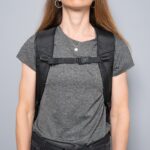Just a few years ago, the idea of packing a proper espresso maker for your travels seemed like a far-fetched dream. The notion of crafting a rich, authentic shot of espresso with a device small and robust enough to accompany you on your adventures was simply not within reach. However, thanks to remarkable advancements in coffee technology and design, the landscape has dramatically changed. Today, a plethora of Travel Espresso Makers are available, promising to deliver café-quality coffee no matter where your journey takes you.
As someone who has spent years exploring the world of manual espresso machines, I’ve had the pleasure of testing a wide range of portable options. In this article, I’ll share my insights on the top travel espresso makers that have truly impressed me, alongside a few others that, while frequently recommended, might not quite live up to the hype. My aim is to provide you with a clear guide to choosing the best travel companion for your espresso needs, ensuring you don’t have to compromise on your coffee standards, even when you’re miles away from your favorite coffee shop.
Note: While countertop machines like the exceptional Flair 58 offer fantastic espresso, they don’t quite fit the definition of “travel-friendly” due to their size and setup requirements. Therefore, this review focuses exclusively on truly portable espresso makers designed for adventurers and coffee lovers on the move.
Top Travel Espresso Maker Picks for Coffee Lovers on the Go
For those who prioritize unparalleled espresso quality and aren’t constrained by budget, the Leverpresso Pro stands out as an exceptional piece of equipment. Its performance is truly top-tier, delivering shots that rival even high-end home espresso machines. However, it’s worth noting that the Leverpresso Pro is both heavier and significantly more expensive than other travel espresso makers we’ll discuss. For most travelers, more accessible and budget-friendly options might be more practical. Let’s delve into some of these fantastic alternatives that offer great espresso without breaking the bank or your backpack.
For a blend of performance and accessibility, my top recommendations are the Outin Nano and the HUGH Leverpresso V4. Both of these are genuine espresso makers that utilize unpressurized baskets, a key feature for achieving authentic espresso flavor.
The Outin Nano distinguishes itself with its exceptional convenience, boasting both an integrated electric pump and a heating system. This means you can brew espresso virtually anywhere without needing a separate heat source or manual pumping. It’s truly designed for effortless espresso on the go.
However, to unlock the full potential of the Outin Nano and achieve truly exceptional shots, investing in a separate upgrade basket kit is highly recommended. That said, if your priority is ease of use and enjoying a good coffee while traveling, the Outin Nano performs admirably with Nespresso capsules right out of the box, offering a no-fuss coffee solution.
With either the Outin Nano or the Leverpresso V4, you can expect to produce coffee shop-quality espresso shots during your travels. While the Outin Nano’s aesthetic might be considered less visually exciting compared to some of the more stylish gadgets in this category, its functionality and ease of use are undeniable. Like the Leverpresso, using these machines provides that satisfying “barista feel,” connecting you to the espresso-making process in a rewarding way.
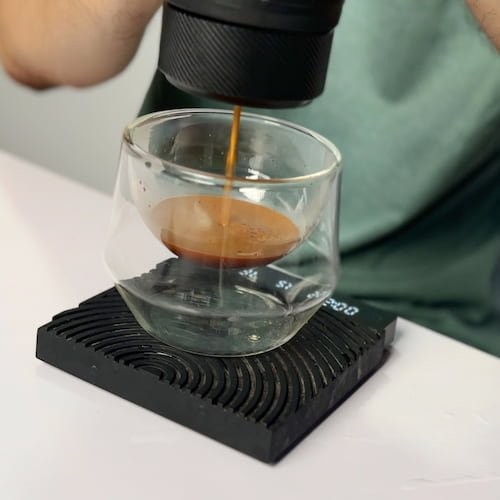 Close-up of Outin Nano portable espresso maker extracting a shot of espresso
Close-up of Outin Nano portable espresso maker extracting a shot of espresso
The Outin Nano portable espresso maker in action, producing an authentic espresso shot with a rich crema.
The Wacaco Picopresso is another highly regarded and popular travel espresso maker that I personally love. While its espresso quality is on par with the Leverpresso V4, a potential concern revolves around its long-term durability. For those prioritizing ultimate portability and lightweight design, the Picopresso has a slight edge. However, if you’re seeking a robust, everyday travel espresso maker, the Leverpresso V4 might be the more durable choice.
The Cafflano Kompresso is the lightest travel espresso maker in this lineup, making it incredibly appealing for minimalist travelers. However, similar to the Picopresso, long-term reliability can be a concern. While I have enjoyed using the Kompresso in the past, it seems the Leverpresso V4 and Picopresso offer a higher potential for consistent, high-quality espresso over time.
It’s generally true that many portable espresso devices face durability challenges. Manually creating espresso requires significant force to achieve the necessary high pressure. When these machines are constructed with plastic components, wear and tear and occasional failures are unfortunately common.
The Flair Neo Flex stands out as the least portable among these options, but it remains compact and lightweight enough to be easily transported around town or packed for shorter trips. It strikes a good balance between affordability, portability, and home use, making it a versatile choice.
The Wacaco Nanopresso and Staresso SP-200, while decent options, don’t quite reach the same level of performance as the other espresso makers in this review. However, if you don’t have access to a high-quality espresso grinder, they are still worth considering. Both utilize pressurized portafilters, which can work well with pre-ground coffee readily available from supermarkets. Interestingly, the Flair Neo Flex also includes an additional basket designed for pre-ground coffee, adding to its versatility.
| Espresso Maker | Shot Quality | Portability | UX | X Factor | Sturdiness | Total |
|---|---|---|---|---|---|---|
| Leverpresso Pro | 5 | 4 | 4 | 5 | 5 | 23 |
| Outin Nano | 4 | 4 | 5 | 5 | 4 | 22 |
| Wacaco Picopresso | 4 | 5 | 4 | 4 | 3 | 20 |
| Leverpresso V4 | 4 | 4 | 4 | 4 | 4 | 20 |
| Cafflano Kompresso | 3 | 5 | 3 | 3 | 2 | 16 |
| Flair Neo Flex | 4 | 2 | 3 | 3 | 4 | 16 |
| Wacaco Nanopresso | 2 | 5 | 3 | 2 | 2 | 14 |
| Staresso SP-200 | 2 | 4 | 3 | 3 | 2 | 14 |
Detailed Reviews of Top Travel Espresso Makers
Wacaco Picopresso: Compact Power for Espresso Lovers on the Move
The Picopresso is a marvel of compact engineering, a handheld travel espresso machine from Wacaco, the innovative Hong Kong-based company also known for the Nanopresso. Wacaco has successfully taken user feedback and improved upon the Nanopresso, creating a truly impressive portable espresso maker.
Having recently tested the Wacaco Picopresso, I was genuinely impressed by the upgrades from its predecessor. The Picopresso boasts a noticeably more robust build quality. Its sturdy, substantial body feels exceptionally well-made and durable, inspiring confidence for travel. The most significant upgrade is the move to a standard 51mm portafilter basket, replacing the Nanopresso’s smaller, pressurized plastic basket. This crucial change unlocks a more authentic espresso-making experience, allowing for a proper double shot with up to 18 grams of coffee.
Wacaco has thoughtfully included several accessories with the Picopresso that cater to the needs of espresso enthusiasts:
- A custom-fitted tamper that cleverly stores within the device itself, ensuring you always have it on hand.
- A dosing funnel that minimizes coffee grounds spillage when loading the basket – a small detail that makes a big difference in usability.
- A WDT (Weiss Distribution Technique) “puck rake” tool designed to break up clumps and improve the distribution of coffee grounds, leading to more even extractions.
- A protective neoprene case that adds a layer of protection during travel and keeps all components neatly organized.
These thoughtful additions demonstrate Wacaco’s understanding of modern espresso aficionados and their desire for a complete, high-quality brewing experience, even on the go. It’s truly impressive attention to detail.
Getting started with the Picopresso is straightforward, though it may take a shot or two to become fully comfortable with the process. The side-mounted pressure arm, while initially feeling a bit unusual, effectively generates ample pressure for proper espresso extraction. The Picopresso’s plastic construction is actually beneficial for travel, making it easy to preheat with hot water before brewing – a crucial step for optimal espresso temperature and flavor. There’s minimal thermal mass to worry about compared to all-metal devices, making preheating quick and efficient.
In terms of espresso quality, the Picopresso consistently outperformed the Cafflano Kompresso, another popular portable option and previous favorite of mine. The espresso produced by the Picopresso exhibited a pleasing body and texture, and the device proved to be more forgiving when it came to grind size variations.
Overall, the Wacaco Picopresso stands out as a highly competent and portable manual espresso maker that offers exceptional value. It represents a significant improvement over the Nanopresso in almost every aspect. In fact, it’s currently one of my top picks among all the portable espresso makers available, perfectly blending performance, portability, and user-friendly design for travelers who demand quality espresso on their journeys.
If you’re intrigued to learn more about this fantastic gadget, I encourage you to check out my detailed review/video for an in-depth look.
See more Wacaco Picopresso reviews on Amazon
OUTIN Nano Portable Espresso Maker: Convenience and Quality Combined for Travelers
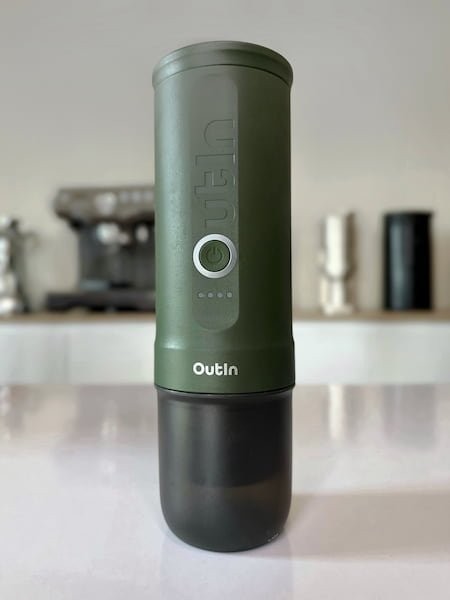 Outin Nano portable espresso maker with a blurred background
Outin Nano portable espresso maker with a blurred background
The Outin Nano portable espresso maker, showcasing its sleek design and compact form factor ideal for travel.
The Outin Nano is a truly unique travel espresso maker that lives up to its promise of delivering excellent espresso wherever you are. It’s remarkably versatile, compatible with both Nespresso capsules and ground coffee, and performs exceptionally well with both options.
What truly sets the Outin Nano apart from other portable espresso makers is its integrated self-heating system. With just the press of a button, it heats water to the ideal brewing temperature, eliminating the need for a separate kettle or heat source. This is a game-changer for true on-the-go espresso brewing.
The Nano offers two distinct operational modes, providing flexibility depending on your needs and power availability:
- Manual Mode: This mode utilizes the electric pump to generate pressure but requires you to add pre-heated water. It conserves battery power, making it ideal when heating water separately is convenient.
- Self-Heating Mode: In this innovative mode, the machine not only pumps but also heats the water for you. This is the ultimate convenience for brewing espresso anywhere, anytime.
While self-heating mode understandably drains the battery faster (yielding approximately 2-3 shots per charge), the sheer convenience it offers for espresso on-the-go is transformative. In my short time testing the device, it has already proven invaluable, rescuing me with a quality espresso during an early morning trip to a government office.
For those seeking to extract the most “serious” espresso from the Outin Nano, I highly recommend investing in the “Nano Basket Plus” upgrade kit. This kit includes an unpressurized basket, a dosing funnel, a WDT tool, and a palm tamper – all essential tools for optimizing espresso extraction.
With the upgrade kit, I was able to achieve impressive results, pulling shots with a 20% extraction yield – a remarkable feat for a portable device. The resulting espresso was sweet, balanced, and full-bodied, rivaling the quality of shots from larger, less portable machines.
The workflow with the Outin Nano is remarkably streamlined and user-friendly, especially compared to manual devices like the Picopresso or Leverpresso. The electric pump removes the physical effort required to generate optimal pressure, making the brewing process effortless.
Weighing in at 658g, the Nano is comparable in weight to its competitors. However, the integrated self-heating system gives it a significant edge in overall convenience and practicality for travel. The build quality is solid, and the unboxing experience reflects a high level of attention to detail, suggesting a premium product.
While the water reservoir is limited to approximately 80ml, a clever workaround exists: you can simply refill the reservoir mid-extraction. This allows you to brew larger volume shots, venturing beyond the typical espresso range into lungo territory.
I’ve experimented with pulling shots at a 1:8 coffee-to-water ratio using lighter filter roasts, and the results have been surprisingly impressive. The Nano’s slightly lower brewing temperature, which can sometimes be a limitation for very light espresso roasts, becomes less of a factor with these longer extraction times.
Furthermore, the absence of a three-way valve (which typically releases pressure and expels excess water in traditional espresso machines) allows you to pause and resume brewing without disturbing the coffee puck. This opens up exciting possibilities for experimenting with techniques like extended pre-infusion or even rudimentary pressure profiling, giving adventurous coffee lovers a unique level of control.
Despite its somewhat unassuming appearance compared to lever-operated devices, the Outin Nano performs exceptionally well in real-world use and easily rivals them in espresso quality. If your priority is fantastic espresso with minimal fuss, especially when you’re off-the-grid, the Outin Nano is exceptionally hard to beat.
For a more in-depth look, check out my full Outin Nano review here.
Official Outin Shop | Outin Nano on Amazon
Flair Neo Flex: Affordable and Portable Espresso for Everyday Adventures
The Flair Neo Flex is Flair’s most budget-friendly offering in their lineup of manual espresso makers. It is designed to provide an accessible entry point into the world of home espresso without sacrificing portability.
This device comes equipped with all the essential components needed to produce quality espresso shots, including both pressurized and unpressurized baskets. The unpressurized basket can even be converted into a bottomless portafilter, giving users more control over their extractions as they gain experience.
One of the most notable features of the Neo Flex is its plastic stand, a departure from the metal frames typically found on other Flair models. While the plastic stand might feel slightly less robust than metal, it significantly reduces the overall weight, making the Neo Flex remarkably lightweight and portable – a key advantage for travel.
Despite its affordability and plastic construction, the Flair Neo Flex delivers surprisingly good espresso. In fact, the shot quality is virtually identical to the Flair Classic, as both models utilize the same brew head design.
Using the Neo Flex is a straightforward process. Simply preheat the brew cylinder, grind and dose your coffee (slightly less than you might use in a larger basket, due to the Neo Flex’s smaller basket size), ensure even distribution, tamp firmly, place the dispersion screen on top of the coffee, and then pull your shot using the lever.
The Flair Neo Flex’s primary selling point is its affordability, making high-quality manual espresso accessible to a wider range of coffee lovers. Its lightweight and easily disassembled design further enhance its appeal as a portable espresso maker. It’s equally at home on your kitchen countertop or packed in a duffel bag for your next adventure.
However, the Neo Flex does have a few design quirks. The inclusion of a pressure release valve seems like a precautionary measure by Flair, perhaps acknowledging the plastic frame’s limitations under high pressure. Despite its budget-friendly price, the Neo Flex is capable of producing espresso shots on par with the well-respected Flair Classic, highlighting its excellent value.
One puzzling design choice is the official omission of pressure gauge compatibility. This may be a deliberate decision by Flair to differentiate the Neo Flex from the Classic and avoid internal competition. While the plastic frame has proven durable in testing, it may not inspire the same level of long-term confidence as the all-metal frames found on higher-end Flair models.
Overall, the Flair Neo Flex represents an outstanding value proposition for those seeking an affordable, daily-use manual espresso maker that doesn’t compromise on espresso quality. Paired with a good quality grinder, it can consistently produce delicious espresso shots. Even with a less-than-perfect grinder, the Neo Flex offers a forgiving entry point into the world of espresso, thanks to its pressurized basket option, making it beginner-friendly.
Having previously tested the Flair Classic and Pro espresso makers, I can confidently say that the taste difference between these models and the Neo Flex is minimal. The Neo Flex is a fantastic tool for learning and mastering the art of manual lever espresso, offering a slightly unusual but rewarding workflow.
Visit the Flair Shop | Flair Neo Flex on Amazon
Leverpresso V4: A Travel-Friendly Upgrade for Espresso Enthusiasts
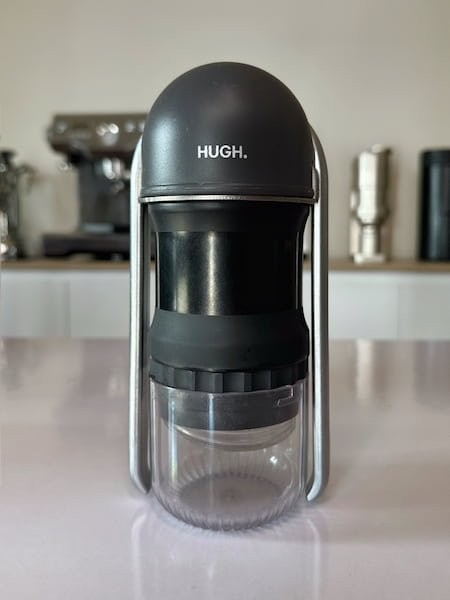 Leverpresso V4 portable espresso maker with a blurred background
Leverpresso V4 portable espresso maker with a blurred background
The Leverpresso V4 portable espresso maker, highlighting its lever-operated design and compact size for travel.
The Leverpresso V4 is the latest iteration of the Leverpresso manual espresso maker, building upon the successes and addressing the shortcomings of its predecessor, the V3. Having been thoroughly impressed with the performance of the higher-end Leverpresso Pro over an extended period, I was eager to test the V4 when HUGH, the manufacturer, sent it to me for review a couple of months ago.
At first glance, the V4 shares a striking resemblance to the Pro model, maintaining the sleek design language with a few key differences that contribute to its more accessible price point.
One of the most significant changes is the absence of a pressure gauge. While some espresso purists might find this disappointing, it’s understandable given the V4’s target price range. However, with practice and developing muscle memory, the lack of a gauge becomes less critical for consistently pulling excellent shots. While the V4 doesn’t include a premium IMS basket like the Pro, it still comes with a high-quality 51mm basket that performs admirably.
Unlike the all-metal construction of the Leverpresso Pro, the V4 utilizes a high-impact plastic material for its body. This design choice is intended to maintain the ability to achieve high pressures while reducing weight and cost. This is a notable improvement over the V3 model, which reportedly suffered from cracking issues due to excessive force. In my daily use of the V4, it has felt remarkably sturdy. However, long-term durability assessments will require more extended use and user feedback.
A standout feature of the Leverpresso design, shared by both the V4 and Pro models, is the dual-lever extraction method, reminiscent of the popular Cafelat Robot. Pressing down on the levers feels smooth and comfortable, making the Leverpresso one of the most user-friendly lever-operated portable espresso makers in this review. However, it’s important to remember that generating espresso-grade pressure still requires considerable force, regardless of the lever mechanism.
While the Leverpresso V4 offers exceptional value for its price, there are a couple of areas where minor improvements could be made. The included plastic tamper feels somewhat basic and doesn’t provide the most precise fit within the basket. A higher-quality tamper, perhaps similar to the excellent one included with the Wacaco Picopresso, would be a welcome addition to better complement the overall design and functionality of the device. On the positive side, the common 51mm basket size means a wide range of aftermarket tampers are readily available.
The rubber caps designed to insulate the brew chamber also feel a bit like an afterthought and can sometimes obstruct your view when filling the chamber with hot water. In practice, I’ve found it easier to simply omit using these caps altogether without significantly impacting brewing performance.
Despite these minor drawbacks, the Leverpresso V4 is an impressive manual espresso maker that delivers excellent espresso quality at a competitive price. For espresso enthusiasts who prioritize portability and travel-friendliness, the Leverpresso V4 strikes a fantastic balance, offering a high-quality espresso experience in a compact and robust package.
Cafflano Kompresso (Hand Carry Coffee Maker): The Ultralight Travel Espresso Champion
The Cafflano Kompresso is a standout for travelers prioritizing minimal weight and size. It’s an incredibly lightweight travel espresso maker, weighing less than 200 grams, and also falls into the category of cheap espresso makers, making it doubly appealing.
Having owned and used the Cafflano Kompresso for several years, I’ve gained extensive experience with its capabilities and unique characteristics. Unlike the Wacaco Nanopresso and Staresso SP200, the Kompresso utilizes a naked portafilter rather than a pressurized basket. This design choice allows for a more authentic espresso brewing experience, focusing on true espresso extraction.
The trade-off for this authentic approach is that the Kompresso demands a much finer grind size, similar to what you would use in a traditional espresso machine. This means pre-ground coffee is generally not suitable. A high-quality manual or electric grinder capable of producing fine, consistent particles is essential to get the best results from the Kompresso.
The brewing workflow with the Kompresso involves a learning curve, as it differs from standard espresso machines. Properly dosing coffee into the relatively small 13-14g basket, carefully placing the dispersion screen, and securely (but not over-tightening) screwing on the portafilter all require some practice. The piston-style pressure mechanism, activated by simultaneously pressing down with your palms and pulling up with your fingers, also demands a bit of finesse to master consistent pressure.
However, once you’ve dialed in your grind size and perfected your technique, the Kompresso is capable of producing surprisingly excellent espresso. The naked portafilter promotes more even extraction, and the ability to use a slightly larger dose yields a richer, more flavorful shot compared to some pressurized portable options. In my testing, the Kompresso has consistently achieved a TDS (Total Dissolved Solids) around 12% and an extraction yield of approximately 20%, firmly placing it within the realm of “real” espresso.
Portability is where the Kompresso truly excels. It is smaller and lighter than any other travel espresso maker in this guide, making it the undisputed champion of ultra-lightweight espresso on the go.
The primary drawbacks of the Kompresso are its learning curve and the absolute necessity of a capable grinder. It’s not as immediately user-friendly or forgiving as pressurized portable espresso makers, and achieving consistently excellent shots requires time, practice, and attention to detail.
Durability is also a consideration. While the Kompresso’s plastic construction feels reasonably robust, the gaskets and small screens are potentially vulnerable to damage over time, especially given the amount of pressure exerted during brewing.
Overall, I highly recommend the Cafflano Kompresso, particularly for experienced coffee enthusiasts who prioritize ultra-portability and have access to a good quality espresso grinder. It’s less ideal for casual users seeking a quick and effortless espresso fix while traveling, but for dedicated espresso lovers willing to invest a little practice, the Kompresso offers a rewarding and remarkably lightweight travel espresso solution.
For a more comprehensive understanding, check out my full review of the Cafflano Kompresso.
See more Cafflano Kompresso reviews on Amazon
LeverPresso Pro Portable Espresso Maker: Premium Quality for the Discerning Traveler
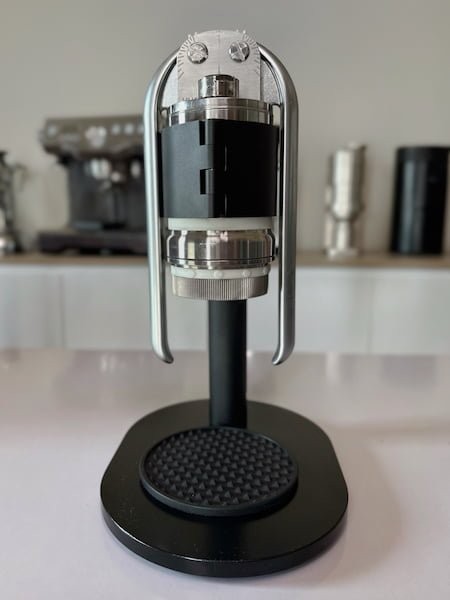 Leverpresso Pro portable espresso maker with blurred background
Leverpresso Pro portable espresso maker with blurred background
The Leverpresso Pro portable espresso maker, showcasing its premium design and robust build quality for travel.
My first impression upon unboxing the Leverpresso Pro was one of genuine admiration. The attention to detail in both the packaging and the device itself is immediately apparent. HUGH, the South Korean company behind the Leverpresso line, has created a product that exudes quality and refinement through its sleek, minimalist design.
While HUGH may not yet be a household name in the global espresso market, they have been steadily building a strong reputation with the Leverpresso V4 and its earlier versions. The Pro model represents a significant step up, featuring all-metal construction, an integrated pressure gauge for precise brewing, and a professional-grade 51mm IMS basket, components typically found in high-end espresso machines.
One of the standout design features of the Leverpresso Pro is its walnut cracker-style dual-lever system, a design reminiscent of the highly regarded Cafelat Robot. I find this lever mechanism exceptionally comfortable and efficient for applying consistent pressure, especially when compared to single-lever portable espresso makers.
Unlike the Cafelat Robot, the Leverpresso Pro offers versatility in its base. It can be used with either a travel-friendly integrated cup for maximum portability or with a separate metal stand for more stable countertop brewing. While the integrated cup enhances portability, it prevents the use of a scale during brewing, as force is applied directly to the entire espresso maker.
HUGH also offers a range of premium accessories specifically designed for the Leverpresso Pro, including a combined tamper/leveler and a heavy-duty dosing funnel. While these add-ons are an additional expense, they are worthwhile investments for users seeking to maximize the Pro’s performance and brewing experience.
Of course, no coffee maker is without minor drawbacks, and the Leverpresso Pro is no exception. The metal stand, while useful for home use, can be somewhat restrictive in terms of the cup sizes and scales it can accommodate. Additionally, the solid steel body requires preheating, particularly when brewing lighter roasted coffees, which may be a slight inconvenience for some users.
In terms of espresso performance, the Leverpresso Pro confidently holds its own against established manual espresso makers like the Cafelat Robot and the Flair Pro 2. It offers comparable build quality and design sophistication. However, this premium quality comes with a similar price tag, placing it at the higher end of the portable espresso maker spectrum.
Where the Leverpresso Pro truly shines is its portability, despite its robust construction. Weighing just under 1 kilogram, it is surprisingly travel-friendly and even light enough to be considered for air travel. Its streamlined design and included travel case make it an exceptional choice for coffee connoisseurs who refuse to compromise on espresso quality, even when they are far from home.
For a more detailed exploration, check out my full Leverpresso Pro review here.
STARESSO SP-200: Versatile and User-Friendly Travel Espresso
The Staresso SP-200 is a compact and capable travel espresso maker, impressively lightweight at just 0.88 pounds. It’s designed for ease of use and portability, making it a convenient option for coffee on the go.
Like many other travel espresso machines, the Staresso SP-200 utilizes a pressurized basket. Despite this, it is still capable of producing surprisingly good extractions and shots with noticeable crema.
(For espresso purists, pressurized baskets are generally less desirable as they can sometimes mute nuanced flavors and result in a slightly less complex extraction compared to unpressurized systems).
While the Staresso’s packaging and included instructions may not be as polished or refined as some of the other brands in this review, the device itself is well-designed and user-friendly in practice.
One key advantage of the Staresso over the Nanopresso is its top-mounted pump mechanism. This design feels significantly more natural and ergonomic to use, making it easier to generate consistent pressure. The sturdy base and included real glass cup also enhance the overall user experience, providing a more stable brewing platform and a more pleasant drinking vessel than the Nanopresso’s plastic cup.
Brewing espresso with the Staresso is a simple and straightforward process. Fill the small basket with approximately 8 grams of ground coffee, insert it into the portafilter, attach it to the main brew chamber, add hot water to the reservoir, attach the pump, and begin pressing. The resulting espresso exhibits a decent amount of foamy crema, and the taste is noticeably fuller and more robust than that produced by the Nanopresso.
In objective testing, the Staresso SP-200 achieved a higher extraction yield (around 17.6%) compared to the Nanopresso. However, it still falls short of the extraction levels typically expected from a traditional espresso machine. Like the Nanopresso, the reliance on a pressurized basket ultimately limits its potential for truly top-tier espresso quality.
However, the Staresso SP-200 boasts a unique and practical feature: it is compatible with Nespresso capsules without requiring any additional accessories. This is a remarkably convenient option for travelers who appreciate the ease of pre-portioned capsules and the assurance of a consistent cup of coffee without the need for grinding and dosing coffee beans on the go.
While I am generally not a strong advocate for capsule-based coffee systems, I was impressed by the sheer ease of using Nespresso capsules with the Staresso. Simply insert a capsule, add hot water, and start pumping – it’s incredibly straightforward. This feature makes the Staresso a particularly appealing travel companion when grinder-less coffee is the most practical option.
If you are traveling and prefer not to carry a separate coffee grinder, the Staresso SP-200 offers a very convenient way to achieve an acceptable level of coffee quality using Nespresso capsules.
You can see a demonstration of the Staresso SP-200 in action in this YouTube video, which provides a visual guide to operating the device.
See more Staresso SP-200 reviews on Amazon
Wacaco Nanopresso Portable Espresso Maker: Stylish Portability, Espresso Anywhere
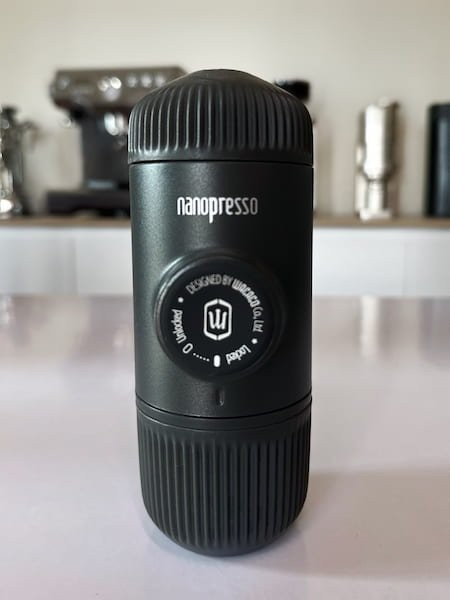 Wacaco Nanopresso portable espresso maker with a blurred background
Wacaco Nanopresso portable espresso maker with a blurred background
The Wacaco Nanopresso portable espresso maker, showcasing its sleek and compact design for coffee on the move.
Several years ago, I had the opportunity to extensively test the Wacaco Nanopresso, a stylish and compact portable espresso maker. My initial impression was very positive, particularly regarding its sleek design and clear, user-friendly instructions. Wacaco has excelled in branding and creating a positive overall user experience with the Nanopresso.
Weighing just 336 grams (less than 1 pound), the Nanopresso is one of the smallest and lightest portable espresso machines available, making it exceptionally convenient for travel.
Using the Nanopresso is relatively straightforward. Fill the small basket with approximately 8 grams of ground coffee, place it in the brew chamber, and screw on the portafilter. Then, fill the separate water tank, attach it to the main body, and begin pumping the side-mounted button to generate pressure.
After a few pumps, espresso will start to flow. I was somewhat surprised by the thick crema the Nanopresso produced, especially considering its compact size and pressurized system. However, the taste of the espresso itself was somewhat underwhelming – mild and somewhat bland, lacking the intensity and strength I typically expect from a true espresso shot. The coffee also tasted slightly cool, suggesting that preheating the device would likely improve the results.
Upon measuring the extraction using a refractometer, I found that the Nanopresso produced a shot with a TDS of approximately 6.65% and an extraction yield of only 13.7%. These measurements indicate a significantly underextracted espresso, likely due to the limitations inherent in its pressurized basket system, which necessitates a coarser grind.
Espresso purists generally avoid pressurized baskets because they can dull the more delicate flavor notes and result in a less potent extraction compared to traditional, unpressurized espresso brewing methods.
While the Nanopresso does produce shots with visually appealing crema, it’s crucial to remember that it utilizes a pressurized basket system. While the crema is aesthetically pleasing, the actual espresso extraction is not as high quality as some of its rivals that employ unpressurized baskets.
While it is possible to modify the Nanopresso for unpressurized brewing, I found the process to be somewhat awkward and ultimately not worth the effort for most users. The side-mounted pump is also less ergonomically ideal for generating the higher pressures required for finer grinds associated with unpressurized baskets.
Overall, the Wacaco Nanopresso is a beautifully designed and remarkably easy-to-use portable espresso maker that produces visually impressive, creamy shots. However, the actual flavor quality and strength of the espresso leave something to be desired, particularly for those accustomed to specialty coffee standards. It is a decent option for those who prioritize extreme portability and ease of use over ultimate flavor fidelity.
In conclusion, while stylish and portable, the Nanopresso is somewhat disappointing compared to the significantly improved Picopresso from the same brand, which offers a more authentic and higher-quality espresso experience in a similarly portable form factor.
See more Wacaco Nanopresso reviews on Amazon
How I Tested These Travel Espresso Makers
As a dedicated coffee equipment reviewer, I have the unique advantage of dedicating my full-time work to thoroughly testing and evaluating the latest innovations in the coffee industry.
Unlike freelance writers or magazine staff who cover a broad spectrum of topics and may only possess a superficial understanding of espresso and the coffee world, my focused specialization allows me to remain at the forefront of recent developments. I actively engage in in-depth discussions and stay abreast of the latest advancements within the coffee community.
This specialization also equips me to test coffee equipment using sophisticated and precise tools, such as refractometers. This allows me to provide you with a far more nuanced and data-driven understanding of coffee equipment performance than what is typically found in mainstream media reviews.
My testing process for the manual espresso makers featured in this article has been extensive and ongoing. Some of these devices were initially compared side-by-side in a series of YouTube videos, providing an opportunity to directly assess their performance, ease of use, and overall build quality. Since those initial tests, I have continued to expand my collection, consistently adding new and noteworthy manual espresso makers to my roster of tested equipment.
It’s important to emphasize that every travel espresso maker included in this guide has been rigorously “battle-tested” by me over time. This long-term, hands-on experience provides you with a more realistic and reliable picture of how these devices perform not just out of the box, but also with continued, regular use.
Conclusion: Choosing the Best Travel Espresso Maker for Your Needs
The world of travel espresso makers has evolved dramatically, offering coffee lovers the ability to enjoy quality espresso anywhere their adventures take them. From the premium performance of the Leverpresso Pro to the ultra-convenience of the Outin Nano and the lightweight portability of the Cafflano Kompresso, there is a travel espresso maker to suit a wide range of needs and budgets.
For those seeking the absolute best espresso quality in a portable format and are willing to invest in premium equipment, the Leverpresso Pro remains a top choice. If convenience and ease of use are paramount, especially for travelers who want an all-in-one solution, the Outin Nano with its self-heating capability is hard to beat. For minimalist travelers and backpackers where every ounce counts, the Cafflano Kompresso offers an incredibly lightweight option without completely sacrificing espresso quality. The Wacaco Picopresso provides a fantastic balance of portability, performance, and user-friendliness, making it a highly versatile choice for many. For budget-conscious espresso lovers, the Flair Neo Flex offers an accessible entry point into manual espresso with surprisingly good results.
Ultimately, the “best” travel espresso maker depends on your individual priorities – whether it’s espresso quality, portability, convenience, ease of use, or budget. Carefully consider your needs and preferences, and choose the travel espresso maker that will be your perfect coffee companion on your next journey. No matter which you choose, you can now confidently enjoy coffee shop quality espresso, wherever you may roam.

